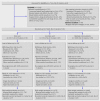Impact of micronutrient supplementation during pregnancy on birth weight, duration of gestation, and perinatal mortality in rural western China: double blind cluster randomised controlled trial
- PMID: 18996930
- PMCID: PMC2577799
- DOI: 10.1136/bmj.a2001
Impact of micronutrient supplementation during pregnancy on birth weight, duration of gestation, and perinatal mortality in rural western China: double blind cluster randomised controlled trial
Erratum in
- BMJ. 2008;337:a2522
Abstract
Objective: To examine the impact of antenatal supplementation with multiple micronutrients or iron and folic acid compared with folic acid alone on birth weight, duration of gestation, and maternal haemoglobin concentration in the third trimester.
Design: Cluster randomised double blind controlled trial.
Setting: Two rural counties in north west China.
Participants: 5828 pregnant women and 4697 live births.
Interventions: Villages were randomised for all pregnant women to take either daily folic acid (control), iron with folic acid, or multiple micronutrients with a recommended allowance of 15 vitamins and minerals.
Main outcome measures: Birth weight, length, and head circumference measured within 72 hours after delivery. Neonatal survival assessed at the six week follow-up visit.
Results: Birth weight was 42 g (95% confidence interval 7 to 78 g) higher in the multiple micronutrients group compared with the folic acid group. Duration of gestation was 0.23 weeks (0.10 to 0.36 weeks) longer in the iron-folic acid group and 0.19 weeks (0.06 to 0.32 weeks) longer in the multiple micronutrients group. Iron-folic acid was associated with a significantly reduced risk of early preterm delivery (<34 weeks) (relative risk 0.50, 0.27 to 0.94, P=0.031). There was a significant increase in haemoglobin concentration in both iron-folic acid (5.0 g/l, 2.0 to 8.0 g/l, P=0.001) and multiple micronutrients (6.9 g/l, 4.1 to 9.6 g/l, P<0.001) groups compared with folic acid alone. In post hoc analyses there were no significant differences for perinatal mortality, but iron-folic acid was associated with a significantly reduced early neonatal mortality by 54% (relative risk 0.46, 0.21 to 0.98).
Conclusion: In rural populations in China antenatal supplementation with iron-folic acid was associated with longer gestation and a reduction in early neonatal mortality compared with folic acid. Multiple micronutrients were associated with modestly increased birth weight compared with folic acid, but, despite this weight gain, there was no significant reduction in early neonatal mortality. Pregnant women in developing countries need sufficient doses of iron in nutrient supplements to maximise reductions in neonatal mortality. Trial registration ISRCTN08850194.
Conflict of interest statement
Competing interests: MJD was consultant for UNICEF China UNICEF Pyongyang during the conduct of the trial. SC was nutrition consultant for UNICEF China from 2001 to 2002, and is now the liaison officer for UNICEF with the Ministry of Health.
Figures


Comment in
-
Micronutrient supplementation in pregnancy in developing countries.BMJ. 2008 Nov 7;337:a1942. doi: 10.1136/bmj.a1942. BMJ. 2008. PMID: 18996929 No abstract available.
References
-
- Jamison JT, Shahid-Salles SA, Jamison J, Lawn JE, et al. Incorporating deaths near the time of birth into estimates of the global burden of disease. 2006. In: Jamison DT, Breman JG, Measham AR, Alleyne G, Claeson M, Evans DB, et al, eds. Global burden of disease and risk factors. New York: Oxford University Press, 2006:427-63. www.dcp2.org/pubs/GBD/6/
-
- Hall S. Neonatal mortality in developing countries: what can we learn from DHS data? Southampton: Southampton Statistical Sciences Research Institute, 2005. (Applications and Policy Working Paper, A05/02). http://eprints.soton.ac.uk/14214
-
- Unicef/WHO/UNFPA. Joint Review of the Maternal and Child Survival Strategies in China, 2006. Beijing: Ministry of Health, 2006.
-
- Mata LJ, Urrutia JJ, Kronmal RA, Joplin C. Survival and physical growth in infancy and early childhood. Study of birth weight and gestational age in a Guatemalan Indian village. Am J Dis Child 1975;129:561-6. - PubMed
Publication types
MeSH terms
Substances
Associated data
LinkOut - more resources
Full Text Sources
Medical
